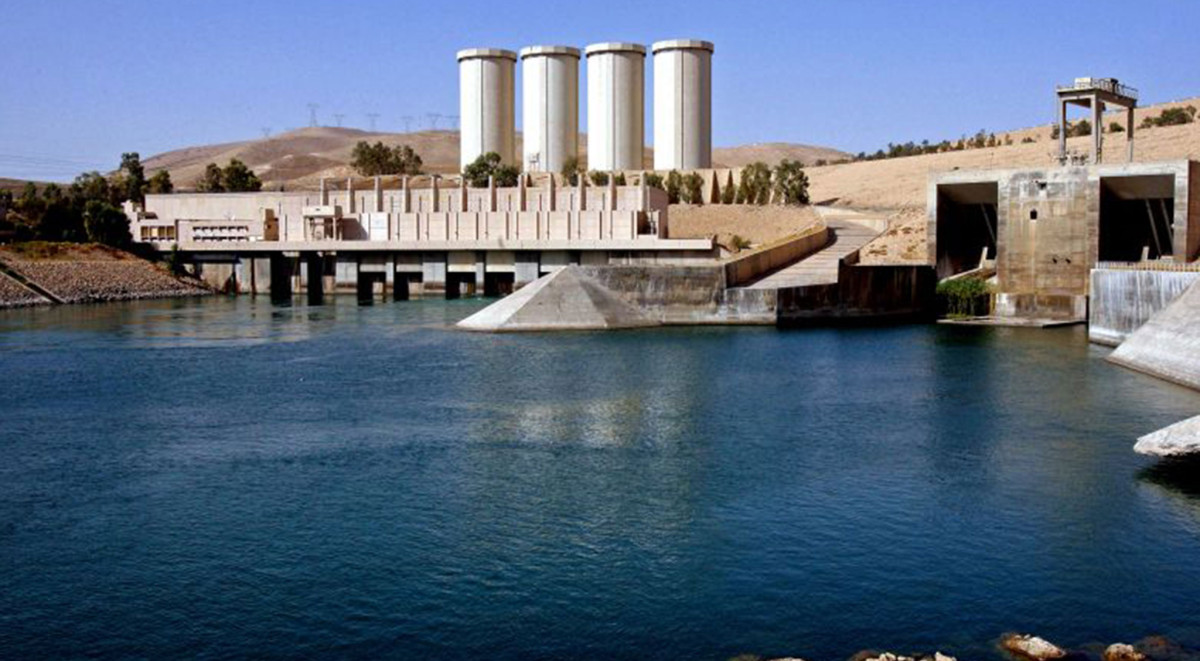
Mar 3 2016, 10:13 am ET
1.5 Million May Die if Mosul Dam Fails: Iraq Expert
by F. Brinley Bruton
Almost 1.5 million Iraqis are in danger of being killed by a wall of water if the dismally maintained Mosul dam collapses, a former senior government engineer who was once in charge of the country’s dam system warned on Thursday.
While the government of Prime Minister Haider al-Abadi has sought to downplay the risk of a collapse of the country’s largest dam, earlier this week it advised many residents of the heavily populated Tigris River valley to move at least 3.5 miles away from its riverbanks.
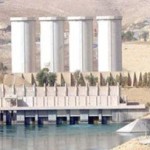
The U.S. Embassy in Baghdad said a collapse of the dam in the north of country would be “serious and unprecedented.” Some 500,000 and 1.47 million Iraqis would “probably would not survive” the wave, while water could reach depths of 45 feet in the nearby city of Mosul, it said in a statement.
Cities downstream on the Tigris River such as Tikrit, Samarra and the Iraqi capital Baghdad could be inundated with smaller, but still significant levels in the event of a breach, U.S. officials warned on Sunday.
“At least a few hundred thousand people will be killed immediately”
Mosul was captures by the militant group, ISIS around two years ago and is the major Iraqi stronghold.
On Wednesday, the Iraqi government signed a 18-month contract worth around $296 million with Italian engineering company Trevi for the upkeep of the facility. Mahdi Rasheed, the general director of the Iraqi Dams Company, told NBC News that Trevi would start sending workers and equipment within days but it would take between two and three months for the repairs to start.
Nasrat Adamo, who was the chief engineer at Iraq’s Irrigation Ministry which oversaw the building and upkeep of the country’s dams, told NBC News he was afraid Trevi’s work would not come soon enough.
“All the figures quote between 500,000 to 1.5 million people in the path” of a collapse, “but at least a few hundred thousand people will be killed immediately,” he said in a telephone interview from Sweden.
“The flood wave is so fast that it would arrive to [the city of] Mosul in two hours and the city would be under 25 meters [82 feet] of water,” Adamo said, citing the findings of a 1984 study conducted by the Iraqi government.
From the day it the dam was inaugurated in the early 1980s it has required intensive maintenance with crews having pour cement under its foundation continuously in what is known as “grouting.”
In 2006, a U.S. Army Corps of Engineers report called it “the most dangerous dam in the world,” The Associated Press reported.
Fears for the dam’s safety worsened as fighting between ISIS, which has conquered swathes of the north of Iraq, and Iraqi forces, intensified in the past years.
In August 2014, Iraqi and Kurdish forces recaptured the dam from ISIS after militants briefly held it.
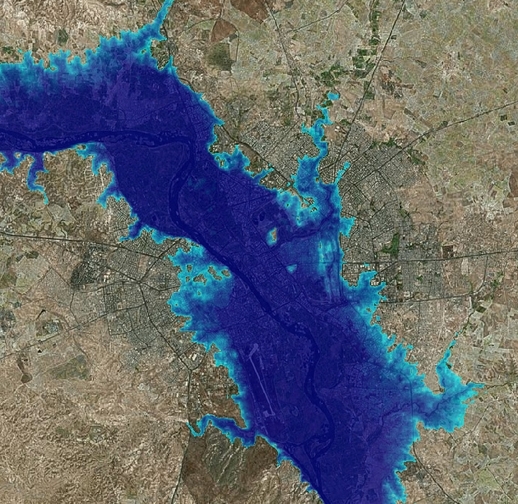
Mosul Dam- Collapse scenario
U.S. Warns of ‘Catastrophic Failure’ of Iraq’s Mosul Dam
By Keith Johnson
February 29, 2016 – 2:28 pm
johnson @KFJ_FP
The United States is ringing alarm bells about the deadly consequences of a breach in the Mosul Dam in northern Iraq, warning publicly over the weekend that a collapse of the 30-year old dam could sow havoc and destruction over a large swath of central Iraq. The unusually public warning from U.S. diplomats suggests that Baghdad has not moved with sufficient urgency to address the dam’s structural problems, nor prepared Iraqis for a possible evacuation, despite years of increasingly alarmed assessments by American technicians.
“Mosul Dam faces a serious and unprecedented risk of catastrophic failure with little warning,” the U.S. Embassy in Baghdad said Sunday in a statement. The embassy also put out a fact sheet on the consequences of a dam collapse, painting an apocalyptic picture of an “inland tidal wave” wreaking devastation along hundreds of miles of flood path from northern Iraq to Baghdad itself. The embassy warned that a dam breach could threaten the lives of 500,000 to 1.5 million Iraqis, knock out the country’s electricity system, and severely disrupt Iraqi agriculture.
A breach “would result in severe loss of life, mass population displacement, and destruction of the majority of infrastructure within the path of the projected flood wave,” the U.S. fact sheet said. Floodwaters would maul big cities like Mosul, Tikrit, Samarra, and Baghdad.
U.S. officials have spent years warning their Iraqi counterparts of the danger of a collapse at Mosul Dam, considered by the U.S. Army Corps of Engineers as the “most dangerous dam in the world.” Former Army Gen. David Petraeus sounded the alarm about a possible collapse in 2007, for example, and the dam’s condition has apparently only deteriorated since then. http://el.erdc.usace.army.mil/elpubs/pdf/tr07-10.pdf A new assessment carried out by U.S. technicians and presented to the Iraqi parliament in late January found that the dam is in worse shape than thought, and that the risk of catastrophic failure is higher than a year ago.
Over the past year, the U.S. team monitoring the dam “has identified significant signs of distress and potential failure progression that were not identified when post-ISIL monitoring began,” the assessment concluded, referring to inspections made just after the Islamic State was dislodged from the facility. “All information gathered in the last year indicates Mosul Dam is at a significantly higher risk of failure than originally understood and is at a higher risk of failure today than it was a year ago,” the report said.
Yet Iraqi officials have been slow to react. In early February, Iraq’s water minister downplayed U.S. warnings and said there is only a “one-in-a-thousand” chance of a dam collapse. Engineers at the dam have also dismissed warnings of structural problems there, as have regional government officials. The office of Iraqi Prime Minister Haider al-Abadi said in a statement Sunday that the dam’s collapse is “very unlikely,” but said that “the serious consequences if it did happen necessitate the alert.”
Built on a porous foundation, the dam has required around-the-clock injections of grout to keep it intact, a necessity even before it began operating. The ongoing maintenance schedule, though, has been disrupted by the Islamic State’s takeover in 2014 of the nearby city of Mosul, and for a brief period of time, the dam itself. U.S. technicians concluded that disruptions to grouting have caused an “unprecedented level of untreated voids in the foundation” of the dam due to ongoing geological erosion.
Concern about the dam’s integrity is mounting, in part because of the new technical assessment carried out this year by U.S. officials.
Earlier this year, it seemed as if Iraq had come up with a possible solution for the at-risk dam, signing a preliminary deal with Italian engineering firm Trevi Group to perform major repair work on the site. Italy’s foreign minister announced the deal, and said Italian troops would provide security for the site.
But a month later, Trevi still has not formally signed a contract for the estimated $300 million job, and it’s not clear that Italian forces will be allowed to operate near the dam, further complicating the repair. The U.S. statement underscored the need for Iraq to move quickly.
“We welcome the [Iraqi] prime minister’s commitment to undertake all necessary measures to rapidly finalize and implement a contract in order to address the structural integrity of Mosul Dam,” the statement said.
The continued campaign of the Islamic State is one reason U.S. officials seem to feel so much urgency about preparing Iraqis downstream from the dam. The terror group, also known as ISIS or ISIL, holds territory between Mosul and the capital, complicating the Iraqi government’s ability to deal with any sudden disaster.
Much of the territory projected to be damaged by a dam breach is contested or ISIL-controlled, suggesting an authority-directed evacuation is unlikely, and that some evacuees may not have freedom of movement sufficient to escape,” the U.S. fact sheet warned.
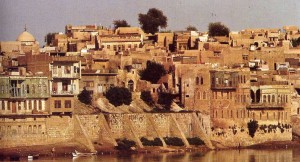
Historic district of Mosul city on the Tigris River – will be the first to go under water.
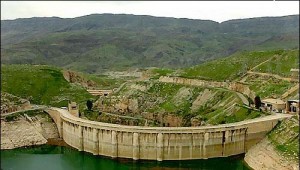
Mosul dam – Potential collapse
U.S. seeks firms for grouting program at Iraq’s 750-MW Mosul Dam
BAGHDAD, Iraq 04/23/2015
The U.S. Army Corps of Engineers seeks information on firms capable of carrying out a 24-hour-a-day grouting program at Iraq’s 750-MW Mosul Dam on the Tigris River. Responses are due May 1.
Mosul Dam was seized by the Islamic State of Iraq and Syria (ISIS or ISIL) in 2014. Control of the hydro project was recovered by a coordinated operation of U.S., Kurdish and Iraqi forces.
The largest dam in Iraq, Mosul was completed in 1984 on a soluble foundation of gypsum, anhydrite, and karstic limestone. To save construction time, foundation grouting was not completed ahead of time. It began seeping immediately upon filling of the reservoir in 1985 in Ninewah Province. Iraq has carried out a major grouting program continuously since that time.
The Corps concluded in 2006 that “in terms of internal erosion potential of the foundation, Mosul Dam is the most dangerous dam in the world… If a small problem at Mosul Dam occurs, failure is likely.” A University of Arkansas civil engineering professor used satellite-based radar images to determine the structure is subsiding at a rate of 8 millimeters per year.
In a sources sought notice, the Corps’ Middle East District seeks information on firms capable of carrying out a 24-hours-a-day, seven-days-a-week grouting program in a concrete-reinforced grouting gallery at the base of the central clay core of Mosul Dam. It plans to use responses as market research to garner interest from industry.
It anticipates issuing a one-year contract with four one-year option periods with an estimated cost of US$250 million to US$500 million.
A sources sought notice may be obtained from the Federal Business Opportunities Internet site, www.fbo.gov, by entering Solicitation No. W912ER15R0018 in the “Keyword/Solicitation #” box.
Responses are due by 4 p.m., U.S. Eastern time, May 1 by e-mail to the addresses below, labeled “Market Research for W912ER-15-R-0018 Mosul Dam.” For information, contact Contract Specialist Cedric Rahming and Contracting Officer Joe Libbey, U.S. Army Corps of Engineers, Middle East District, P.O. Box 2250, Winchester, VA 22604-1450; (1) 540-665-3958; E-mail: cedric.rahming@usace.army.mil, joe.l.libbey@usace.army.mil.
Geologic Setting of Mosul Dam and Its Engineering Implications
Geologic Conceptual Model of Mosul Dam